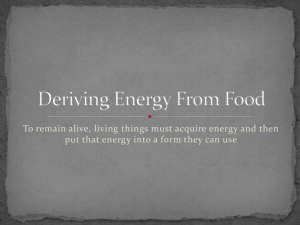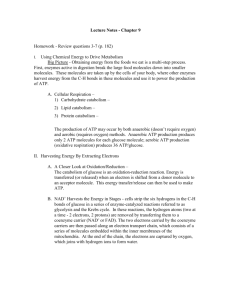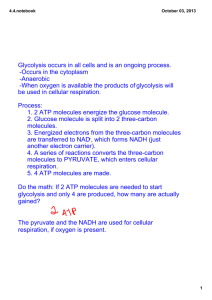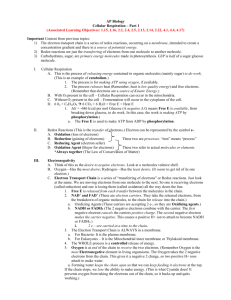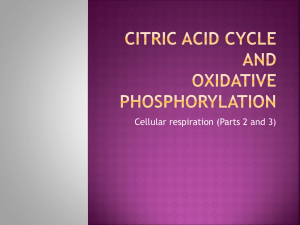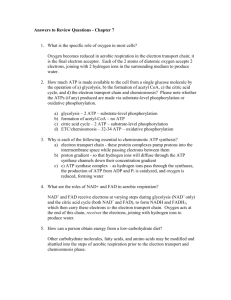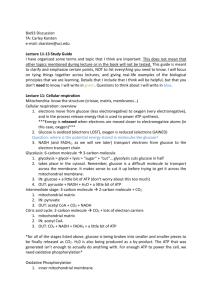biology_chapter_4_notes
advertisement
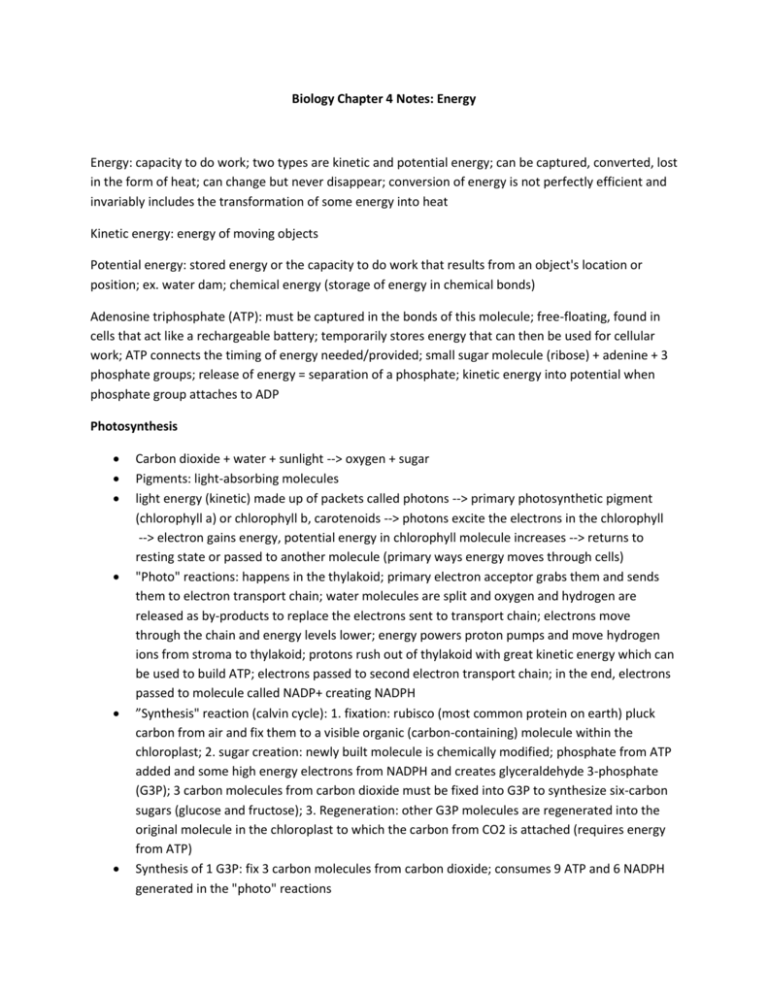
Biology Chapter 4 Notes: Energy Energy: capacity to do work; two types are kinetic and potential energy; can be captured, converted, lost in the form of heat; can change but never disappear; conversion of energy is not perfectly efficient and invariably includes the transformation of some energy into heat Kinetic energy: energy of moving objects Potential energy: stored energy or the capacity to do work that results from an object's location or position; ex. water dam; chemical energy (storage of energy in chemical bonds) Adenosine triphosphate (ATP): must be captured in the bonds of this molecule; free-floating, found in cells that act like a rechargeable battery; temporarily stores energy that can then be used for cellular work; ATP connects the timing of energy needed/provided; small sugar molecule (ribose) + adenine + 3 phosphate groups; release of energy = separation of a phosphate; kinetic energy into potential when phosphate group attaches to ADP Photosynthesis Carbon dioxide + water + sunlight --> oxygen + sugar Pigments: light-absorbing molecules light energy (kinetic) made up of packets called photons --> primary photosynthetic pigment (chlorophyll a) or chlorophyll b, carotenoids --> photons excite the electrons in the chlorophyll --> electron gains energy, potential energy in chlorophyll molecule increases --> returns to resting state or passed to another molecule (primary ways energy moves through cells) "Photo" reactions: happens in the thylakoid; primary electron acceptor grabs them and sends them to electron transport chain; water molecules are split and oxygen and hydrogen are released as by-products to replace the electrons sent to transport chain; electrons move through the chain and energy levels lower; energy powers proton pumps and move hydrogen ions from stroma to thylakoid; protons rush out of thylakoid with great kinetic energy which can be used to build ATP; electrons passed to second electron transport chain; in the end, electrons passed to molecule called NADP+ creating NADPH ”Synthesis" reaction (calvin cycle): 1. fixation: rubisco (most common protein on earth) pluck carbon from air and fix them to a visible organic (carbon-containing) molecule within the chloroplast; 2. sugar creation: newly built molecule is chemically modified; phosphate from ATP added and some high energy electrons from NADPH and creates glyceraldehyde 3-phosphate (G3P); 3 carbon molecules from carbon dioxide must be fixed into G3P to synthesize six-carbon sugars (glucose and fructose); 3. Regeneration: other G3P molecules are regenerated into the original molecule in the chloroplast to which the carbon from CO2 is attached (requires energy from ATP) Synthesis of 1 G3P: fix 3 carbon molecules from carbon dioxide; consumes 9 ATP and 6 NADPH generated in the "photo" reactions Combating Water Loss combating water loss through evaporation: close stomata (pores on underside of leaves that opens up for carbon and oxygen; although water is lost, carbon and oxygen cannot enter/release C4 Photosynthesis: adds extra set of steps to minimize water loss; has enzymes that attract carbon dioxide strongly; binds to carbon when CO2 concentration is very low; requires more energy than C3 photosynthesis; oxygen released at night Carssulacean acid metabolism (CAM): used by cacti, pineapples, fleshy juicy plants that close stomata during hot dry days; holding molecules store CO2 until needed; slower growth Cellular Respiration oxygen + sugar --> carbon dioxide + water + ATP glycolysis: splitting of sugar; splits into two molecules called pyruvate (2 ATP used); payoff after split = 4 ATP + 2 NADH + water Pyruvate molecule --> passes electrons to NAD+ into NADH; releases carbon dioxide --> the C2O attaches to coenzyme A into acetyl-CoA --> ready to enter krebs cycle Acetyl CoA adds to oxaloacetate into 6-carbon molecule --> NADH is made and 2 carbon dioxide is exhaled --> 4 carbon molecule oxaloacetate is reformed --> ATP is generated --> electrons passed to NADH and FADH2 ATP built in electron transport chain in Mitochondria 90% of energy payoff is from NADH and FADH2 interspace membrane is studded with electron carriers (chain); NADH and FADH2 donate electrons and hydrogen ions enter the intermembrane space; free hydrogen ions form water and the rest are pushed back up into the mitochondrial matrix with great kinetic energy and used to build ATP; cyanide prevents electron transport chain to bind with electrons; halting production of ATP Other Metabolisms acid buildup occurs when bodies are demanded of bursts of energies; oxygen deficiencies begin and slowdown of ATP production occurs Cellular resp w/o water: animals accept pyruvate and produce lactic acid while yeast accepts acetaldehyde and end product is ethanol Complete Diets Sugars: must be separated into simple sugars for glycolisis --> Acetyal-CoA production --> krebs --> electron transport chain --> energy Lipids: into fatty acid --> 1. acetyal-CoA 2. --> glycerol --> glycolysis --> acetyal-CoA Proteins: into carbon compounds --> 1. glycolysis 2. krebs cycle 3. amino group
